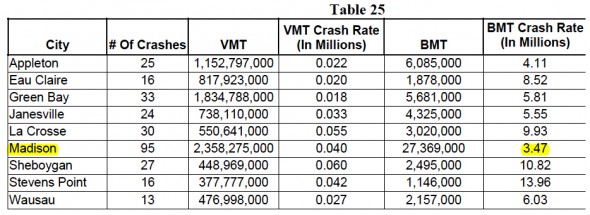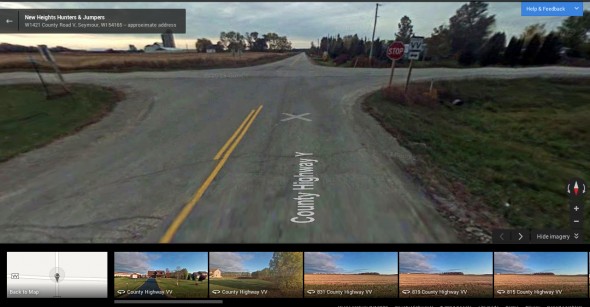Is Safety on Rural Roads a Problem?
Are rural roads less safe than urban streets for bicyclists? A fatal crash in Seymour raises questions.
The Outagamie County Sheriff is still investigating a crash that left a person riding a bicycle dead and puts the fatality count at nine this year compared to eight at the same time in 2012. If you look at the statistics from the most recent weekly fatal report, you can see that most fatal crash numbers are down, but with the exception of people riding bicycles. Although the count is up, since millions of people have ridden bicycles in Wisconsin this year and fewer than ten have died, I still contend riding a bike is a safe and healthy way to get around.
| BICYCLIST | 9 | BICYCLIST | 8 |
| DRIVER | 186 | DRIVER | 201 |
| MC DRIVER | 54 | MC DRIVER | 64 |
| MC PASSENGER | 2 | MC PASSENGER | 10 |
| PASSENGER | 52 | PASSENGER | 83 |
| PEDESTRIAN | 24 | PEDESTRIAN | 25 |
This latest crash at an intersection of two county roads near the small town of Seymour, population 3,451, is a good example of what he is talking about. So far this year, only one person was killed riding a bicycle in Milwaukee, population 597,867, yet 50% of the Milwaukee population rides bicycles. Only two in Madison, 236,901 despite the fact that nearly 10% of the 236,901 people who live in our state Capitol ride bikes to work every day, compare to less than 1% for the rest of the state. Why is it seemingly safer to ride in big cities than out on low-volume town roads in rural Wisconsin?
Is Tom right? Is it more dangerous to ride a bicycle outside the city? A while ago I was part of a review committee for a statewide bicycle crash study done by WisDOT staff. Here is what their study found:
“The report and analyses found that the largest concentration of bike-motorist crashes occurred at intersections on urban arterial streets – 94% of them were reported in urban areas while 66% occurred at intersections. Rural crashes represented only 6% of all crashes in the state, but almost 80% were on roads with 55 mph posted speeds. The fatal crash rate based on bicycle miles traveled was almost twice as high in rural areas as in urban areas.”
So the answer is a bit more nuanced, in that crashes are more likely to happen on major arterial streets in urban areas, but the risk of a fatal crash is higher on rural roads. We are sorely lacking in good statistical information on bicycle travel, but the WisDOT study went on to try to compare relative risk based on bicycle miles traveled (BMT). To get this information, they relied on the National Household Travel Study (NHTS). Wisconsin purchased tens of thousands of additional surveys to provide statistically reliable sample sizes for most of the state’s metropolitan areas and several counties. I think the NHTS significantly undercounts bicycle miles traveled, but it is the only apples-to-apples data we have to use.

Source: Bicycle Crash Analysis for Wisconsin using a Crash Typing Tool (PBCAT) and Geographic Information System GIS by Michael Amsden and Thomas Huber June 2006.
The graph above that I pulled from the report illustrates the point Tom Bamberger is trying to make. The authors of the report make a similar claim:
The City of Madison achieved the lowest crash rate based on BMT at 3.47 crashes per million BMT while Stevens Point was on the other end of the spectrum at 13.96 crashes per million BMT. La Crosse, Sheboygan and Eau Claire all had relatively high rates with 9.93 per million BMT, 10.82 per million BMT and 8.52 per million BMT respectively.
Madison went from a moderately high crash rate based on VMT alone to the lowest crash rate based on BMT. This is because of its extraordinarily high amount of BMT for the city. This reversal in rates illustrates the importance of using a variety of crash rates to describe conditions and to realize that all crash rates have inherent limitations that can overstate or understate crash conditions.
Similarly, Peter Jacobson’s 2003 exhaustive study of cities around the world, Safety in numbers: more walkers and bicyclists, safer walking and bicycling, found there is safety in numbers:
“Conclusion: A motorist is less likely to collide with a person walking and bicycling if more people walk or bicycle.”
The “Safety in Numbers Theory” is often cited, but more a more recent study done in California drilled down further and found that part of the reason more people ride bicycles in some cities than others is good cycling infrastructure. Yes, cities like Davis, California and Portland, Oregon not only have high percentages of people riding bicycles and correspondingly low bicycle crash rates, but they also have bicycle facilities that make it safer and more attractive to ride. In Evidence on Why Bike-Friendly Cities Are Safer for All Road Users by Wesley E. Marshall, Norman W. Garrick had this conclusion:
“Overall, cities with a high bicycling rate among the population generally show a much lower risk of fatal crashes for all road users when compared to the other cities in our database. The fact that this pattern of low fatality risk is consistent for all classes of road users strongly suggests that the crashes in cities with a high bicycling rate are occurring at lower speeds. This agrees with the finding that street network density was one of the most notable differences found between the safer and less safe cities. Our data suggest that improving the streets and street networks to better accommodate bicycles may lead to a self-reinforcing cycle that can help enhance overall safety for all road users.”
Environmental Practice 13:16–27 (2011)
The take away from all these wonky studies should come as no surprise: If you want to make it safer and more attractive to ride bicycles, build bikeways that people find safer and more attractive, like trails, protected bike lanes, cycle tracks, and bicycle boulevards. Those bikeways not only encourage more people to ride, which in itself reduces crash rates because drivers of motor vehicles expect to share the roads with bicycles. Also important, though, is that the streets designed for bicycle, pedestrian and motor vehicle traffic turn out to be safer for all users.
We will have more details on the crash in Seymour as soon as the authorities release them, but until then, you can ride your bike with confidence that it is a relatively safe and healthy thing to do. But don’t forget to advocate for more attractive modern bicycle facilities in your community. Better bikeways and streets designed from the beginning with bicycling and walking in mind are safer for all road users.
This article was originally published by the Bicycle Federation of Wisconsin.
Bike Czar
-
Join a Bike Ride Under the Polish Moon
 Jun 1st, 2018 by Dave Schlabowske
Jun 1st, 2018 by Dave Schlabowske
-
9 Reasons to Join National Bike Challenge
 May 4th, 2018 by Dave Schlabowske
May 4th, 2018 by Dave Schlabowske
-
Biking Through the Mindoro Cut
 Apr 27th, 2018 by Dave Schlabowske
Apr 27th, 2018 by Dave Schlabowske























This is great little analysis of the safety issues affecting rural riders.
That said, I’m wondering why this is being published on Urban Milwaukee.
Why shouldn’t this be published here?
Like I said it is a well written and interesting article. It shouldn’t be here, however, because it is about issues affecting bicyclists in rural areas. It was my understanding this website was devoted to issues affecting URBAN Milwaukee.
@Hereiam To me the story compared rural riding to urban riding safety issues. And argues dedicated bicycle infrastructure is how we can make all riders safer. Quote: “The take away from all these wonky studies should come as no surprise: If you want to make it safer and more attractive to ride bicycles, build bikeways that people find safer and more attractive, like trails, protected bike lanes, cycle tracks, and bicycle boulevards.”
Fits just fine in mind.
As a resident of Milwaukee, I didn’t know I couldn’t ride my bike in rural areas and that I shouldn’t care about people who do.
Thanks Hereiam, the word is a better place for your PSA.
As a resident of Milwaukee, you’re allowed to do and care about a lot of things, that doesn’t mean that Urban Milwaukee should dedicate time and space to international travel or war crimes in Syria.
That being said, there is a history of biking related stories here, and this did compare urban biking to rural biking. I didn’t see any issue with the topic like Hereiam did, but Tim’s logic is worse.